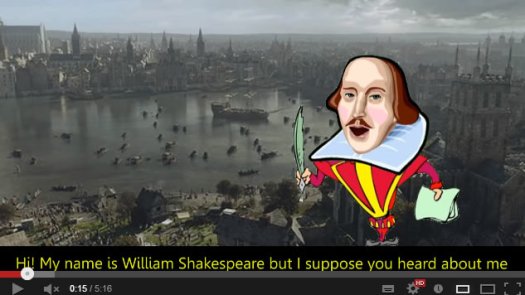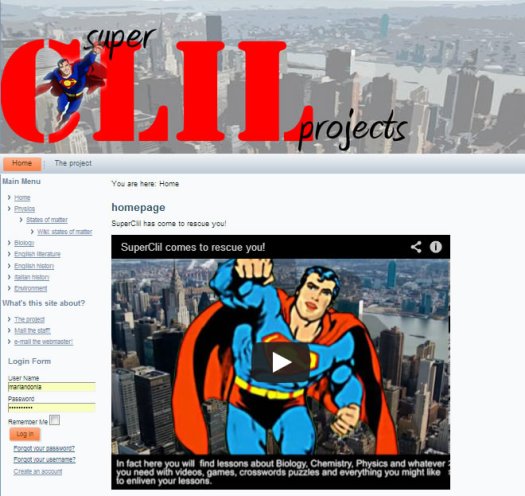www.CLIL-projects.eu : a Website for CLILteachers
Maria Antonietta Sessa, Italy
Maria Antonietta Sessa is an English language teacher living in Benevento, Italy. She has worked in international projects with European and Asian partner schools since 2002. In her teaching practice she makes extensive use of Web 2.0 Internet applications and other “computer nerd’s stuff”. E-mail: marses@tin.it
Menu
Introduction
Background: two problems teachers are coping with today
a. A new anthropological species: the Digital Natives
b. CLIL (Content and Language Integrated Learning)
Examples …
Conclusions
References
In my teaching career I have always had making my lessons more appealing to my students as a primary goal. Honestly, in the latest years, my battle has become almost hopeless. As a matter of fact it seems that pleasing students has got particularly difficult to teachers. New teaching/learning strategies, even in the most conservative countries, have found their way into school curricula but, paradoxically, this only seems to put even more pressure on teachers.
One of the trendiest methodologies of the moment is certainly CLIL.
In this article I will show my personal view of the causes that today are making teaching so demanding to teachers and I will also try to outline a possible practical solution. The solution regards CLIL teachers in particular and aims at turning CLIL from a challenge into a resource both for teachers and students.
Nowadays teachers are dealing with a different type of learners: the “digital natives”; i.e. kids who have spent their existences texting and googling since the very day they were born. This new type of teenager always looks self-assured and “focused-on-task” when playing videogames or texting; yet the same teenager suddenly becomes puzzled and hazy when asked to write an essay about “The most beautiful day in my life” or “A trip to the country”. Mobile phones do not help: even when school rules strictly ban their use in the classroom, they seem to emerge as science fiction submarine creatures from the surface of the ocean and they turn into a serious disrupting factor since students seem to be more keen on secretly chatting on Facebook with friends on their smart phones than in collaborating with their classmates at group works in the classroom.
Another typical characteristic of our “third millennium student” is the following one: if we ask them to draw a picture of their pc they will certainly produce little masterpieces; on the contrary, they will not be able to draw a cow for the simple reason they have never seen one. Could the generation gap between them and us teachers be wider than that? The question is a rhetorical one since everybody knows the answer…
Researchers tell us that as a result of intensive exposure to visual media the student perceptual system has dramatically changed: hearing seems to have become their weakest sensory channel while other senses (sight in particular) prevail. Moreover, the immersion in 3D, or even 4D, virtual environments has caused them to adapt to such powerful and intense stimuli our chalk-and-board classes cannot compete with. The result is that teachers often feel frustrated when they realize that their lessons, traditionally based on auditory inputs, suffer in the comparison with the media the kids are constantly exposed to outside school.
There seems to be no chance to find a mutual understanding as teachers usually remark that students’ attention span has become short to the point of non-existence while, on the other side of the barricade, students accuse their teachers to be too talkative.
In Italy, following the reform of curricula, in a couple of years CLIL teaching will become mandatory in the final classes of all high schools. Consequently, in a relative short time, many teachers who have always taught curricular subjects different from English, will be asked to teach the same subjects in English. As a matter of fact the average level of English language competences of Italian teachers (with the obvious exception of teachers of English) varies from zero to “just a little”. On the other hand Italian teachers who teach English will have to face the problem of teaching scientific subjects for which they have no academic education. From what we have roughly outlined it is evident that Italian CLIL teachers belong to two categories:
- English teachers who have no proper academic background as regards curricular subjects other than English
- Non-English teachers whose level of mastery of English language is generally very low.
Actually, the difference in knowledge and skills between the teachers belonging to these two educational fields is so huge that there exists no common ground which might help the integration between the respective competencies.
Recently the MIUR (Italian Ministry of Education) has organized several language actions to help non-English teachers learn the basics of the English language, which certainly is the most popular foreign language studied in Italian schools. Anyway, one-week Comenius 2.2 courses in the UK , while being a wonderful and valuable opportunity to refresh one’s knowledge of the language, can by no means be the solution to reach the required language competence when the learner/teacher is an absolute (or even false) beginner.
In the recent years I have tried new visual ways to propose learning content to my students and I have always been surprised at seeing how quickly and deeply they get engaged when watching videos or movies. For this reason I started developing my own videos with a view to using them as Learning Objects. I will tell you the story of my experience:
The first video I developed is about the Elizabethan theatre: the storyteller is a cartoon character representing William Shakespeare himself. In fact the title of the video is “The Elizabethan Theatre explained by Willy”. The video has been visualized by 18.000 visitors at the moment I am writing. The URL is: http://www.youtube.com/watch?v=P0SBg-KG4C4
The technical aids that I need in the classroom to use this (or any other) video are a pc and a projector. An interactive board would be perfect, of course! When these facilities are not available at school I usually ask the students to watch the video at home and answer some comprehension questions as part of the homework. The video lasts about 7/8 minutes and it tells many relevant information in a very light-hearted way.
I soon noticed that videos can make my life as a teacher much easier: students seem to be riveted on the screen and enjoy “soaking up” the story narrated by Willy, the cartoon character.
I started to think that if videos were useful to me they could be even more beneficial to CLIL teachers, in particular to that category of teachers who will before long face the terrible task of teaching their subjects in English, no matter how low their level of English was.
Since my scientific education consists in what I learned at high school many years ago, I decided to ask my Biology, Chemistry and Physics colleagues to collaborate at my project: the roles were thus distributed: I would be in charge of both English language and video-editing while my colleagues would take care of the accurateness of the scientific texts.
We used our colleagues at school as unconscious “guinea-pigs” and the feedbacks we got from them were highly encouraging.
Yet we were not completely satisfied: the videos were lying scattered on the Internet Space and were therefore difficult to be found by possible viewers .

Teachers also told us the videos were nice and engaging but more instructional materials like activities and tests were still necessary if we wanted to attain our goal of making CLIL teaching easy for everybody.
The developing team decided to have a debriefing session during which the members brainstormed and came to the conclusion that we had to take the following further steps in our campaign in “defence of Italian CLIL teachers”:
- First of all we had to publish the videos on a website
- Secondly we had to develop more materials supporting the videos so that each section or webpage could be used as a complete Learning Object.
At the moment our website (URL: www.clil-projects.eu) is still a work in progress and, since the range of subjects that it should cover is utterly endless, it will remain like that for a long time.

Anyway our “creature” is starting to take shape and, what’s more, is growing very fast! As you will see, at the moment I am writing, there are already several sections and some of them are even fairly complete.
Physics: in the Physics menu section there is a main page with an excerpt from Wikipedia describing the meaning and range of this subject. Hidden in page there is an audio file developed with a synthesis speech software. The audio comment helps students and teachers get through the traps and deceptions of English language phonetics. After that there is an interactive multiple-choice quiz.

The submenu is connected to two webpages: “States of matter” and “Wiki: states of matter”. In the first page there is a video with Albert Einstein, a cartoon character that gives any possible information about the five states of matter in just 7 minutes. This video, like any other, has English subtitles.

After watching the video students can solve the online interactive crossword puzzle on the States of matter. The puzzle offers immediate feedback and clues in case the student does not know the answers. After completing the puzzle students get the scores in a playful non-judgemental way, exactly as it happens with videogames. This is not surprising if we consider that the philosophy inspiring the whole website is Gamification, which means: trying to make easy and fun what is usually difficult and boring, by adopting the same techniques that make videogames so amusing and engaging.

The page „Wiki: states of matter” presents more information from the online encyclopaedia.
At the moment I am writing you will find the next sections on the website: Biology, English literature (“Elizabethan theatre explained by Willy” and a “Fling the teacher” interactive quiz), English history (the Celts), Italian history (An interview to Arechi II, Santa Sofia’s – Prince Arechi II’s Church), Environment (videos about wind energy, “How the Earth will be saved in the year 2050”), Arts (a video with Mona Lisa telling the mysteries of Leonardo’s most famous portrait), Unusual History (video about the history of Caribbean Piracy with myself and a colleague “starring” among the others) and two videos about environmentally-friendly habits at home.
As I said before, we have just set out on our journey which promises to be a very long one since the subject matter areas we wish to cover are really vast. In conclusion, there are several reasons for which we can say: “the sky is the limit!”
Jane McGonigal, (2011) Reality Is Broken / Penguin Group US
Eric Jensen, (June 1996) Completing the Puzzle / Brain Store, Incorporated
Eric Jensen, (1998) Teaching with the brain in mind / Association for Supervision and Curriculum Development
Eric Jensen, (1995) / Brain-Based Learning / Pearson Education
Dave Meier (29 June 2000)/ The Accelerated Learning Handbook/ McGraw Hill Professional
Jane Revell and Susan Norman (1995) In your hands: NLP in Elt / Saffire Press
Jane Revell and Susan Norman (1999) Handing over / Saffire Press
Sheelagh Deller, Christine Price (2007) Teaching Other Subjects Through English (CLIL) /
OUP Oxford
Aaron Dignan, (2001) Game Frame / Free Press

Please check the CLIL: Content and Methodology for Primary Teachers course at Pilgrims website.
Please check the CLIL: Content and Methodology for Secondary Teachers course at Pilgrims website.
Please check the CLIL Materials Development ( Advanced Level) course at Pilgrims website.
Please check the ICT - Using Technology in the Classroom – Level 1 course at Pilgrims website.
Please check the ICT - Using Technology in the Classroom – Level 2 course at Pilgrims website.


|